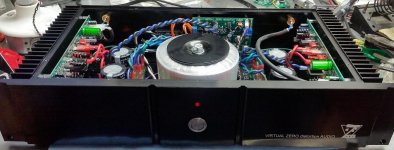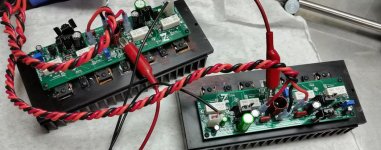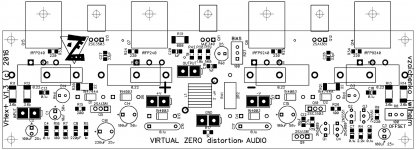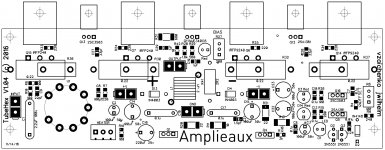VHex+ started as a fun project and grew into a mature line of amplifiers.
This is a great sounding amplifier, built and appreciated by many people around the globe. Very inexpensive for the level of sound quality it provides.
It's easy to build and very reliable in the long run.
Key specifications with +/-50V rails (VHex+ Classic):
- Maximum output power: 100W @ 8 ohm; 160W @ 4 ohm
- Voltage gain 29db
- Input impedance 27 Kohm
- THD: 1KHz - 0.005%, 10KHz - 0.008%, 20KHz - 0.01% (measured at 50W @ 8 ohm)
- IMD: 14+15KHz - 0.005% (measured at 50W @ 8 ohm)
For VHex+ Classic we offer (note - the price is for a pair!):
- Assembled modules for a stereo amp (without or with the heatsinks);
- Kit for a stereo amp (PCBs + parts);
- Boards set for a stereo amp (PCBs only).
A recent addition to VHex+ product line:
- TubeHex boards set with the tube-based IPS.
PSU boards and Control / Protection System variants are also available.
We provide a comprehensive building guide and technical support for every build.
We do care about the result.
Cheers,
Valery & Jeff
Virtual Zero Audio Store
P.S. 10% discount for your 1-st order (use "welcomefriends" discount code at checkout), valid till August 31, 2018.
This is a great sounding amplifier, built and appreciated by many people around the globe. Very inexpensive for the level of sound quality it provides.
It's easy to build and very reliable in the long run.
Key specifications with +/-50V rails (VHex+ Classic):
- Maximum output power: 100W @ 8 ohm; 160W @ 4 ohm
- Voltage gain 29db
- Input impedance 27 Kohm
- THD: 1KHz - 0.005%, 10KHz - 0.008%, 20KHz - 0.01% (measured at 50W @ 8 ohm)
- IMD: 14+15KHz - 0.005% (measured at 50W @ 8 ohm)
For VHex+ Classic we offer (note - the price is for a pair!):
- Assembled modules for a stereo amp (without or with the heatsinks);
- Kit for a stereo amp (PCBs + parts);
- Boards set for a stereo amp (PCBs only).
A recent addition to VHex+ product line:
- TubeHex boards set with the tube-based IPS.
PSU boards and Control / Protection System variants are also available.
We provide a comprehensive building guide and technical support for every build.
We do care about the result.
Cheers,
Valery & Jeff
Virtual Zero Audio Store
P.S. 10% discount for your 1-st order (use "welcomefriends" discount code at checkout), valid till August 31, 2018.
Attachments
Last edited:
links do not open for me
Hmm... that's pretty strange.
If you just go to Virtual Zero Audio Store - does it open at all?
The site is hosted at Shopify in the US - works fine for me.
Hi Fred,
VHex+ is a combination of simplicity and very high performance.
This design has got a number of specialties:
- the front-end, combination of the LTP, Lender arrangement and a current-driven VAS. It's highly linear, low internal noise, immune to external noises.
- OPS is simple, well temperature-compensated, low-enough distortion and rather inexpensive.
Many builders and testers appreciated the natural, uncolored sounding of VHex+.
The tube at the input is a matter of taste. It's a good input device in general. Both options perform very well, although I didn't run any thorough A/B test.
If you dare to compare them - please share your impressions
In addition - we support every build, making sure the amplifier works as expected. We do care about the result.
Cheers,
Valery
Impressions by Gregory G. - one of the owners of VHex+, who performed a very good build:
VHex+ clean build, Greg G. (US) – Virtual Zero Audio Store
Cheers,
Valery
VHex+ clean build, Greg G. (US) – Virtual Zero Audio Store
Cheers,
Valery
Hi !
I'm interested in your "Simpelstark PLUS V1.3 kit (2 x PCBs + parts)"
As I fried some time ago (stupid accident) one module/board of my dual-mono power amplifier, I already have a chassis with everything inside:
2 SMPS PSUs +/- 47.5 V unregulated (is this OK with your boards)
speaker protection, heatsinks etc
Is it a class AB setup ? What type of mosfets are you using ?
What's its damping factor ?
Thanks
JMK
I'm interested in your "Simpelstark PLUS V1.3 kit (2 x PCBs + parts)"
As I fried some time ago (stupid accident) one module/board of my dual-mono power amplifier, I already have a chassis with everything inside:
2 SMPS PSUs +/- 47.5 V unregulated (is this OK with your boards)
speaker protection, heatsinks etc
Is it a class AB setup ? What type of mosfets are you using ?
What's its damping factor ?
Thanks
JMK
Hi !
I'm interested in your "Simpelstark PLUS V1.3 kit (2 x PCBs + parts)"
As I fried some time ago (stupid accident) one module/board of my dual-mono power amplifier, I already have a chassis with everything inside:
2 SMPS PSUs +/- 47.5 V unregulated (is this OK with your boards)
speaker protection, heatsinks etc
Is it a class AB setup ? What type of mosfets are you using ?
What's its damping factor ?
Thanks
JMK
Hi JMK,
Simpelstark is a rather special amplifier. The "core" of it is an ultra-linear amplifier with the "standard" 29db voltage gain and no global feedback loop.
On top of that, it's equipped with Only Distortion Negative Feedback (18db loop gain), crystallizing the error signal and injecting it at the input of the OPS, mixing it with the VAS signal at 180 degrees phase shift. That's the point where the error signal is subtracted from the VAS output signal, although it corrects the overall error of the amplifier, as this kind of arrangement is equivalent to the global loop of 18db in principle.
The amplifier provides very natural sound throughout the whole audio frequency range without any coloration or "highlighting" any parts of it. We call it a "Delicate Sound" amplifier. Real hi-end
This is a class AB setup, but the OPS arrangement is sort of non-standard - its a "constant gm" type of OPS with the EF driver stage running at 110mA of quiescent current (class A), and then a couple of pairs of common emitter "supporting" transistors, running at just 20-30mA each.
The output impedance of the amplifier is close to 0.05 ohm, resulting in the damping factor of around 150 with 8 ohm speakers. I deliberately keep it not too high - too much of control over the speaker is not always good. In general, "the more is the better" statement is incorrect with regards to the damping factor.
+/- 47.5 V DC unregulated is ok, although we have never practically tested this amplifier with SMPS power supplies. I don't see any issues though.
We don't use any MOSFETs in this version of the amplifier - the OPS purely consists of the BJT power transistors (one pair of 0281/0302 and two pairs of 3281/1302 in each channel).
IPS requires one pair of 2sk246/j103 jFETs, relatively rare, but still available these days.
The kits are available in our store.
Let me know if you will have some more questions
Cheers,
Valery
P.S. BTW, you can see an overall topology in the comments to my post on FB:
Just finished testing and measuring the... - Virtual Zero Audio Store | Facebook
Last edited:
Hello Vaizchenko
greetings all parts for the simplestark pcbs have arrived managed to
get matched input mosfets BL grade waiting for the construction guide and setting
up procedure from you
warm regards
Andrew
Hi Andrew,
Good news
OK, I will intensify my work on the building guide for Simpelstark PLUS - hope to have it finished in a few days.
Cheers,
Valery
Hello valery
greetings just wanted to ask you if MJL4281/4302 can be used as i have
bought them and do the 1381/3503 E grade transistors have to be matched
warm regards
Andrew
Hi Andrew,
Yes, 4281/4302 are good to go with.
1381/3503 matching makes sense, although don't try to match them too precisely. In fact, if hFE differs less than 2 times - it's ok.
Cheers,
Valery
Building it
Thanks for this quick and detailed answer.
Is there anything special needed for the building?
All parts provided with the kit (beside heatsinks) ?
Is it possible to have a look at the building manual ?
JMK
Hi JMK,
Simpelstark is a rather special amplifier. The "core" of it is an ultra-linear amplifier with the "standard" 29db voltage gain and no global feedback loop.
On top of that, it's equipped with Only Distortion Negative Feedback (18db loop gain), crystallizing the error signal and injecting it at the input of the OPS, mixing it with the VAS signal at 180 degrees phase shift. That's the point where the error signal is subtracted from the VAS output signal, although it corrects the overall error of the amplifier, as this kind of arrangement is equivalent to the global loop of 18db in principle.
The amplifier provides very natural sound throughout the whole audio frequency range without any coloration or "highlighting" any parts of it. We call it a "Delicate Sound" amplifier. Real hi-end
This is a class AB setup, but the OPS arrangement is sort of non-standard - its a "constant gm" type of OPS with the EF driver stage running at 110mA of quiescent current (class A), and then a couple of pairs of common emitter "supporting" transistors, running at just 20-30mA each.
The output impedance of the amplifier is close to 0.05 ohm, resulting in the damping factor of around 150 with 8 ohm speakers. I deliberately keep it not too high - too much of control over the speaker is not always good. In general, "the more is the better" statement is incorrect with regards to the damping factor.
+/- 47.5 V DC unregulated is ok, although we have never practically tested this amplifier with SMPS power supplies. I don't see any issues though.
We don't use any MOSFETs in this version of the amplifier - the OPS purely consists of the BJT power transistors (one pair of 0281/0302 and two pairs of 3281/1302 in each channel).
IPS requires one pair of 2sk246/j103 jFETs, relatively rare, but still available these days.
The kits are available in our store.
Let me know if you will have some more questions
Cheers,
Valery
P.S. BTW, you can see an overall topology in the comments to my post on FB:
Just finished testing and measuring the... - Virtual Zero Audio Store | Facebook
Thanks for this quick and detailed answer.
Is there anything special needed for the building?
All parts provided with the kit (beside heatsinks) ?
Is it possible to have a look at the building manual ?
JMK
Thanks for this quick and detailed answer.
Is there anything special needed for the building?
All parts provided with the kit (beside heatsinks) ?
Is it possible to have a look at the building manual ?
JMK
Hi JMK,
All the parts will be provided for building the amplifier modules. PSU and COntrol System modules are the separate kits, but as I understand you've got those things in place already.
Setup procedure will be described in the building manual. This is a relatively new product, so the manual is in the final stage of development now - I will let you know as soon as it's done in a few days.
Cheers,
Valery
Hi Valery,
I just order a PCB board, but i cannot download the build guide, could you please direct me to the link? or maybe can attached the file here.
thanks,
odie
Hi Odie,
Thank you for your order. I have opened the downloads area for you.
Please click the "Building Guides" link under the DOWNLOADS title at the bottom of the homepage and download the building guide for VHex+ Classic amplifier.
Let us know if you will have some questions on the build.
Cheers,
Valery
Very interesting your new amp.
Simpelstark PLUS V1.3 kit (2 x PCBs + parts) – Virtual Zero Audio Store
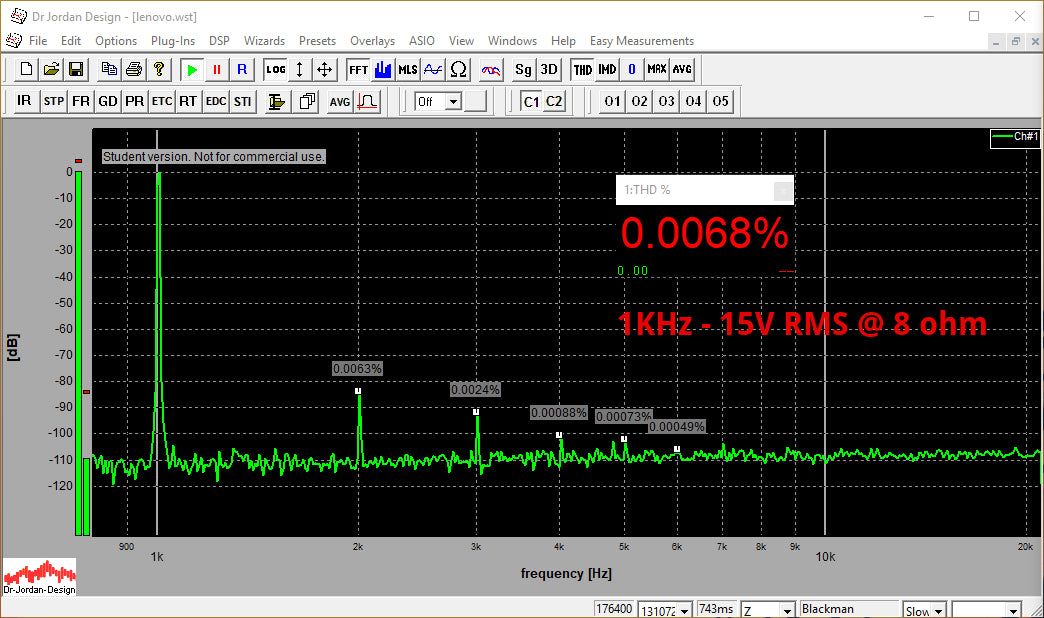
Post your Solid State pics here.
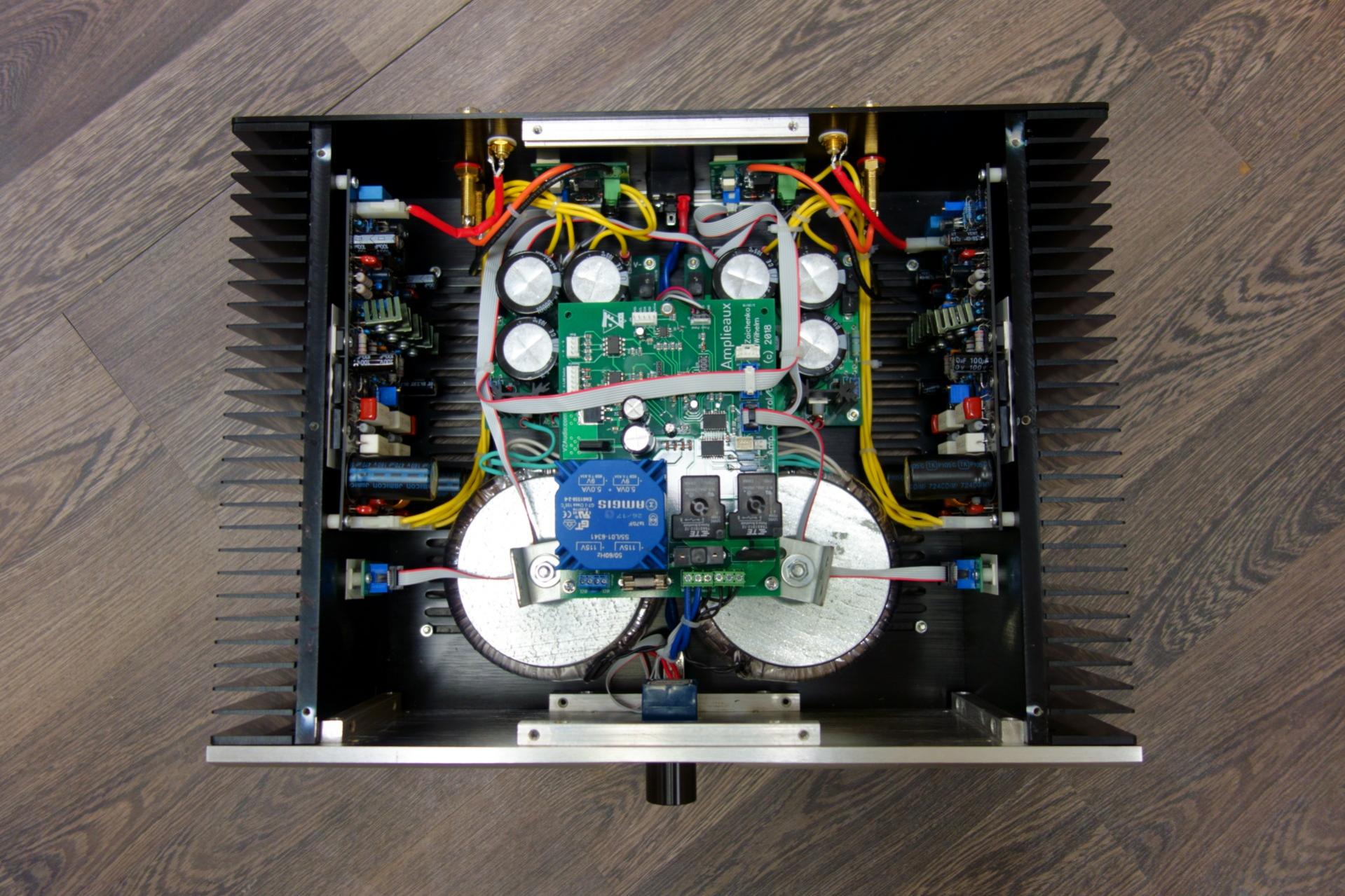
Simpelstark PLUS V1.3 kit (2 x PCBs + parts) – Virtual Zero Audio Store
SNR A-weighted at 1 watt and 100 watts?A specialty of this design is high linearity of every stage and low amount of global negative feedback - only 18db of ODNF error correction. The amp is particularly good for acoustic music - jazz, classics, guitars, vocals, drums, cymbals, etc.
The amplifier is dead silent at idle, which is a big advantage for listening at the low volumes and/or with some high-sensitivity speakers.

Post your Solid State pics here.
Last edited:
Which is the "better" amplifier? The VHex or Simplestark?
Hi Pelayostyle,
Here is my view on this:
VHex+ is an amplifier with a much higher amount of negative feedback and lower output impedance, resulting in more control over the speaker. It's fast and low-distortion, providing very punchy bass drum hits at any volumes.
Some people use it as a reference amplifier when comparing the speakers, because of its overall "transparency" and neutrality.
Particularly good for extensive rock, electronic, jazz, big band, etc.
Simpelstark+ is more "chamber" kind of amplifier, giving the speakers more freedom. It's got an excellent distortion profile, usually seen at the tube amplifiers, although the absolute distortion level is slightly higher than the one for VHex+.
This one is great for acoustic music with all its micro-nuances at all volumes - the sound is extremely natural, like if the musicians would be playing in your room. The noise level of this amplifier is so low - you can hear any lowest level details when the most of the instruments are close to silence, playing some low-volume music fragment.
Hope this helps
Cheers,
Valery
- Status
- This old topic is closed. If you want to reopen this topic, contact a moderator using the "Report Post" button.
- Home
- Vendor's Bazaar
- VHex+ amplifier modules, kits and boards
